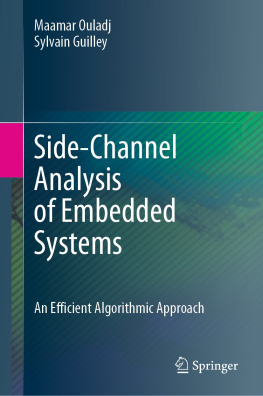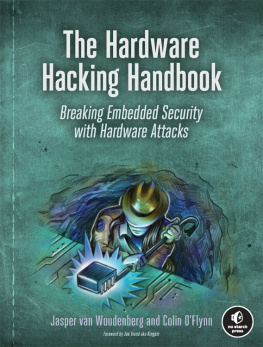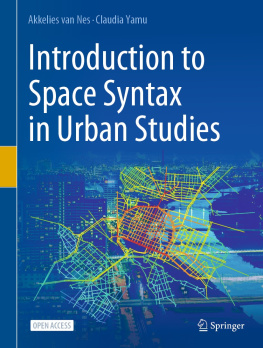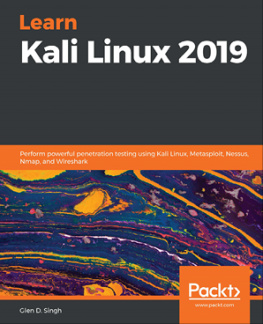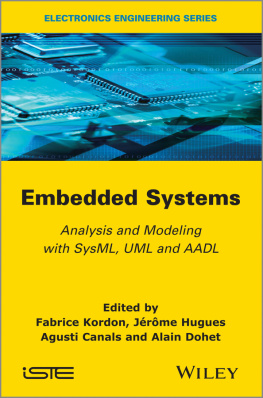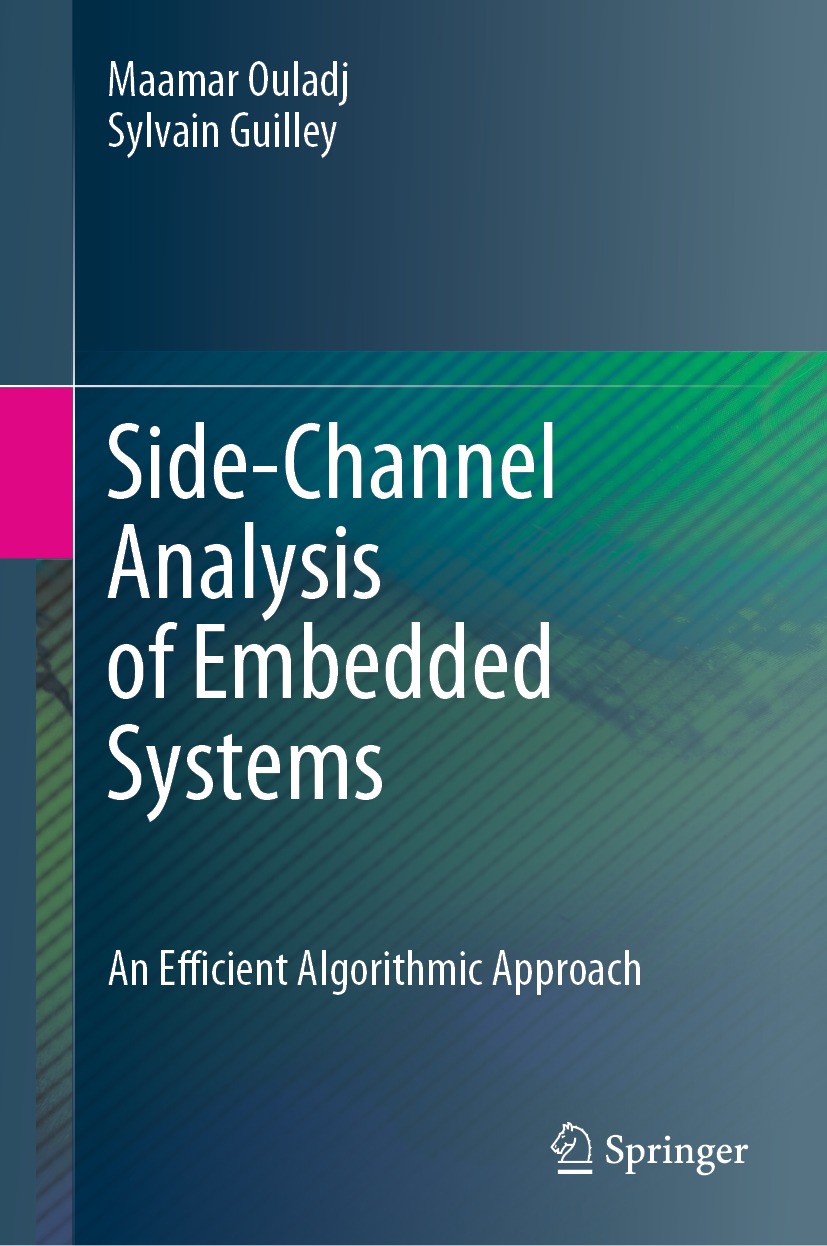Maamar Ouladj and Sylvain Guilley
Side-Channel Analysis of Embedded Systems
An Efficient Algorithmic Approach
1st ed. 2021

Logo of the publisher
Maamar Ouladj
Paris 8 University, Paris, France
Sylvain Guilley
Secure-IC, S.A.S., Paris, France
ISBN 978-3-030-77221-5 e-ISBN 978-3-030-77222-2
https://doi.org/10.1007/978-3-030-77222-2
The Editor(s) (if applicable) and The Author(s), under exclusive license to Springer Nature Switzerland AG 2021
This work is subject to copyright. All rights are solely and exclusively licensed by the Publisher, whether the whole or part of the material is concerned, specifically the rights of translation, reprinting, reuse of illustrations, recitation, broadcasting, reproduction on microfilms or in any other physical way, and transmission or information storage and retrieval, electronic adaptation, computer software, or by similar or dissimilar methodology now known or hereafter developed.
The use of general descriptive names, registered names, trademarks, service marks, etc. in this publication does not imply, even in the absence of a specific statement, that such names are exempt from the relevant protective laws and regulations and therefore free for general use.
The publisher, the authors and the editors are safe to assume that the advice and information in this book are believed to be true and accurate at the date of publication. Neither the publisher nor the authors or the editors give a warranty, expressed or implied, with respect to the material contained herein or for any errors or omissions that may have been made. The publisher remains neutral with regard to jurisdictional claims in published maps and institutional affiliations.
This Springer imprint is published by the registered company Springer Nature Switzerland AG
The registered company address is: Gewerbestrasse 11, 6330 Cham, Switzerland
Contents
Part I Classical Side-Channel Attacks
Part II Spectral Approach in Side-Channel Attacks
Part III Coalescence-based Side-Channel Attacks
The Author(s), under exclusive license to Springer Nature Switzerland AG 2021
M. Ouladj, S. Guilley Side-Channel Analysis of Embedded Systems https://doi.org/10.1007/978-3-030-77222-2_1
1. General Introduction
Maamar Ouladj
(1)
Paris 8 University, Paris, France
(2)
Secure-IC, S.A.S., Paris, France
Todays digital era connects everyone and everything in between through the Internet of Things (IoTs). That situation leads to an omnipresence of embedded systems in our daily life endowed with integrated capability to run cryptographic protocols (consumer electronics, telecommunication and industrial appliances, governmental and military systems, etc.). Those need to manage authorized access, firmware integrity, life-cycle irreversible steps, and so on. Thus, the functional correctness of IoTs is an absolute prerequisite. Nevertheless, unless suitable care is given, cryptographic protocol implementations in both software and hardware happen to leak sensitive information during their execution. Side-Channel Attacks (SCA) is a scientific field whose purpose is the analysis of this leaked information, in order to recover the secret parameters of the protocols. In the seminal paper on Side-Channel Attacks (SCA), published by Kocher et al. [], or a contention for Central Processing Unit (CPU) resources such as cache memories.
In practice, small devices (such as smart cards) are common targets of SCA. But, also larger devices such as smartphones and computers can be attacked through their side-channel leakage [].
The SCA requires two steps, namely:
side-channel emanation traces collection from the device;
analysis of the traces, altogether referred to as the acquisition campaign, to extract the sensitive information.
The first step requires some acquisition skills, which is typically carried out by automated experimental benches, as, for instance, described in Chap. 3 of []. The second step is essentially agnostic with respect to the attacked device, in that it consists in distinguishing the correct secret key from several hypotheses.
As stated in the SCA literature, according to the adversary abilities (knowing or not the leakage model of the device, having or not a copy of this target device, ...), the optimal attack is either the Correlation Power Analysis (CPA) [].
This book addresses the following topics:
the correct implementation of the SCA distinguishers, and
their optimal algorithmic implementation in terms of speed.
Instead of carrying out an SCA straightforwardly on the raw traces, one can carry it out using the averaged leakage per message value []. In this book, we first generalize the use of the Walsh-Hadamard transform for any situation. Consequently, using both of the coalescence principle, the spectral approach, and others optimizations, we provide several improvements of the implementation complexity in both of CPA, LRA, and the Template attacks. All these improvements of the complexities are conflated and put in perspective in this book. They lead asymptotically to optimal SCA assaults, from a computational standpoint, even in presence of countermeasures.
The attacks will be illustrated throughout this book on the running example of the Advanced Encryption Standard (AES []).
Outline and Contributions
The present book is structured in three parts. The first part consists in the state of the art about known attacks. The second part contains the efficient processing of the prominent attacks put forward in the first part.
The beginning of the Part I provides a state of the art of Side-Channel Analyses (SCAs) through three chapters. Chapter consists in some foundations of side-channel attacks. Namely, a general framework of SCA is introduced, then different leakage models are given, and eventually different security metrics are defined. Also we introduce different techniques used for trace pre-processing, leakage-wise.
Chapter tackles the most important side-channel distinguishers. Namely, we introduce Simple Power Analysis (SPA), Differential Power Analysis (DPA), Correlation Power Analysis (CPA, either using Pearson or rank-based statistics), Covariance-Based Distinguisher, Collision Side-Channel Attacks, Mutual Information Analysis (MIA), Kolmogorov-Smirnov Distance (KS)-based distinguisher, Chi-squared Test (Chi-2-Test)-based distinguisher, Template Attack (TA), Linear Regression-based Side-Channel Attacks (LRA), Machine Learning Distinguishers, and the most recent Higher Order Optimal Distinguisher (HOOD).
In Chap. , we introduce the different countermeasures aiming at stymying SCA attacks, namely, the hiding (on the time/amplitude dimension) and the masking techniques. For the time dimensions hiding, we introduce both of the random insertion of dummy operations, the jittering, and the shuffling of operations. For the amplitude dimensions hiding, we introduce the two complementary techniques for reducing the Signal-to-Noise Ratio (SNR), namely, the noise increase and the signal reduction. For the masking countermeasure, we introduce different known masking schemes, namely, the Boolean Masking (BM), the Multiplicative Masking (MM), the Affine Masking (AfM), the Arithmetic Masking (ArM), the Polynomials-based Masking (PM), Leakage Squeezing Masking (LSM), the Rotating S-boxes Masking (RSM), the Inner Product Masking (IPM), and the most recent Direct Sum Masking (DSM) schemes. After that, we introduce an extension of the DSM to a so-called Multi-shares Direct Sum Masking (DSM).

